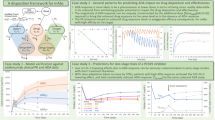Abstract
Biologics, especially monoclonal antibodies (mAbs), are an increasingly important part of the drug discovery and development portfolio across the pharmaceutical industry. To enable robust demonstration of pillars 1 and 2 [1] for mAbs, specialised assays are required to measure the complex interactions between mAb and target. This is especially important for the interpretation of soluble target interactions. In some instances, multiple assays with overlapping purposes (e.g., developing both complex and total assays) have been developed. In retrospect, these efforts may have led to excessive time and resources spent in assay development and the generation of data that is contradictory or misleading. Our recommendation is to invest resources early into the development of total assays for both mAb and target. Free target assay data may be inaccurate and report higher levels of free target than are present in the sample at collection due to re-equilibrium during measurement. Total assay formats are inherently less sensitive to the effects of sample preparation, assay conditions, and re-equilibration than free or complex assays. It is acknowledged that pathology/pharmacology is ultimately driven by the free target and knowledge of its dynamics are critical. However, generation of appropriate total target data and using model-based estimation of free target concentrations is a more robust approach than utilisation of direct assay derived estimates. Where free data are utilised, the potential biases should be prospectively considered when developing the assay and utilising the data for quantitative analyses.
Graphical Abstract







Similar content being viewed by others
References
Morgan P, et al. Can the flow of medicines be improved? Fundamental pharmacokinetic and pharmacological principles toward improving phase II survival. Drug Discov Today. 2012;17(9–10):419–24.
Lee JW, et al. Bioanalytical approaches to quantify “total” and “free” therapeutic antibodies and their targets: technical challenges and PK/PD applications over the course of drug development. AAPS J. 2011;13(1):99–110.
Zheng S, McIntosh T, Wang W. Utility of free and total target measurements as target engagement and efficacy biomarkers in biotherapeutic development—opportunities and challenges. J Clin Pharmacol. 2015;55(Suppl 3):S75-84.
Hood J, et al. Pharmacokinetic-pharmacodynamic modelling of systemic IL13 blockade by monoclonal antibody therapy: a free assay disguised as total. Pharmaceutics, 2021;13(4).
Wang W, et al. Mechanistic pharmacokinetic/target engagement/pharmacodynamic (PK/TE/PD) modeling in deciphering interplay between a monoclonal antibody and its soluble target in cynomolgus monkeys. AAPS J. 2014;16(1):129–39.
Talbot JJ, et al. Measurement of free versus total therapeutic monoclonal antibody in pharmacokinetic assessment is modulated by affinity, incubation time, and bioanalytical platform. AAPS J. 2015;17(6):1446–54.
Kuang B, King L, Wang HF. Therapeutic monoclonal antibody concentration monitoring: free or total? Bioanalysis. 2010;2(6):1125–40.
Pouliquen IJ, et al. Characterization of the relationship between dose and blood eosinophil response following subcutaneous administration of mepolizumab. Int J Clin Pharmacol Ther. 2015;53(12):1015–27.
Kasaian MT, et al. IL-13 antibodies influence IL-13 clearance in humans by modulating scavenger activity of IL-13Ralpha2. J Immunol. 2011;187(1):561–9.
Ait-Oudhia S, Lowe PJ, Mager DE. Bridging clinical outcomes of canakinumab treatment in patients with rheumatoid arthritis with a population model of IL-1beta kinetics. CPT Pharmacometrics Syst Pharmacol. 2012;1: e5.
Yang J, Quarmby V. Free versus total ligand-binding assays: points to consider in biotherapeutic drug development. Bioanalysis. 2011;3(11):1163–5.
Hansen RJ, et al. Qualification of a free ligand assay in the presence of anti-ligand antibody Fab fragments. MAbs. 2013;5(2):288–96.
Neubert H, et al. Protein biomarker quantification by immunoaffinity liquid chromatography-tandem mass spectrometry: current state and future vision. Clin Chem. 2020;66(2):282–301.
Dua P, Hawkins E, van der Graaf PH. A tutorial on target-mediated drug disposition (TMDD) models. CPT Pharmacometrics Syst Pharmacol. 2015;4(6):324–37.
Shah DK, Betts AM. Towards a platform PBPK model to characterize the plasma and tissue disposition of monoclonal antibodies in preclinical species and human. J Pharmacokinet Pharmacodyn. 2012;39(1):67–86.
Davda JP, et al. A model-based meta-analysis of monoclonal antibody pharmacokinetics to guide optimal first-in-human study design. MAbs. 2014;6(4):1094–102.
Gibiansky L, et al. Approximations of the target-mediated drug disposition model and identifiability of model parameters. J Pharmacokinet Pharmacodyn. 2008;35(5):573–91.
Funding
This research was funded by GSK.
Author information
Authors and Affiliations
Contributions
DF and HT wrote the manuscript.
Corresponding author
Ethics declarations
Conflict of Interest
DF and HT are employees of GSK and may hold stock and/or patent applications in the company.
Additional information
Publisher's Note
Springer Nature remains neutral with regard to jurisdictional claims in published maps and institutional affiliations.
Rights and permissions
Springer Nature or its licensor (e.g. a society or other partner) holds exclusive rights to this article under a publishing agreement with the author(s) or other rightsholder(s); author self-archiving of the accepted manuscript version of this article is solely governed by the terms of such publishing agreement and applicable law.
About this article
Cite this article
Fairman, D., Tang, H. Best Practices in mAb and Soluble Target Assay Selection for Quantitative Modelling and Qualitative Interpretation. AAPS J 25, 23 (2023). https://doi.org/10.1208/s12248-023-00788-4
Received:
Accepted:
Published:
DOI: https://doi.org/10.1208/s12248-023-00788-4




